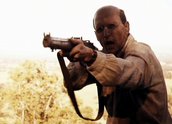


Broken Sun (2008)
Synopsis
In 1944 Jack (Jai Koutrae), a New South Wales farmer still suffering physically and psychologically from his experiences in the First World War, has been living a solitary existence until he discovers and captures Masura (Shingo Usami), a Japanese prisoner of war who has taken part in a mass escape from a nearby prison camp. Via flashbacks and the men’s halting conversations – Masura speaks English – the viewer learns the two men have similar attitudes towards death and mercy killing and their psyches are damaged by their bitter war experiences. As events reach a conclusion it becomes obvious the men have developed a significant bond, yet the circumstances of war conspire to break them apart.
Curator’s notes
Although it doesn’t refer to the events by name – the setting is given simply as south-west New South Wales, 1944 – Broken Sun is clearly inspired by actual events when Japanese prisoners of war broke out en masse from a prison camp near Cowra, New South Wales, in August 1944, leading to the deaths of 231 Japanese and four Australians.
This story was previously treated in The Cowra Breakout (1984), a four-and-a-half hour 1984 mini-series from Kennedy Miller Productions, directed by Phillip Noyce and Chris Noonan. Broken Sun pursues several of the same themes – Japanese attitudes towards honour and shame, suicide, the mercy killing of injured comrades, the psychological damage of war to soldiers on both sides – but works on a much smaller canvas. A major strength is the imagination and resourcefulness with which director and producer Brad Haynes has overcome the constraints of a less than $50,000 budget. Aided by Anthony Jennings’s fine high definition digital cinematography, Matteo Zingales’s dramatic orchestral score, and impressive production design (uncredited), the film pointedly avoids the stock-in-trade of ultra-low budget cinema such as black-and-white grainy footage and shaky hand-held camera, and makes resonant use of symbols and visual motifs such as corrugated iron and barbed wire to create meaningful echoes and links between different timelines and events.
To add psychological depth and provide backstory, the present day timeline is punctured by multiple flashbacks from the point of view of each character – including episodes when Jack raided the enemy trenches at night during the First World War and later killed a German prisoner with his bayonet, and Masura’s traumatic experiences fighting in the Pacific. The intensity and verisimilitude of these sequences is a tribute to the acting and direction.
- Overview
- Curator’s notes
- Video 3 clips

- Principal credits
- Find a copy
- Make a comment
- Map
- Add your review



